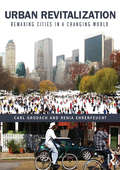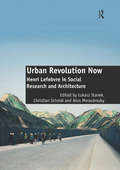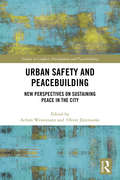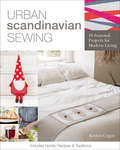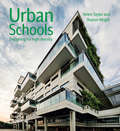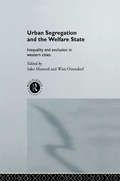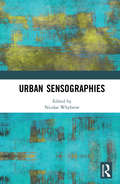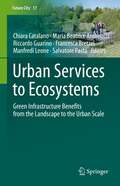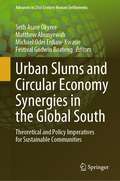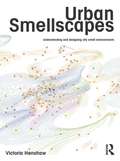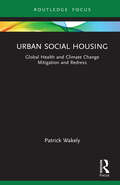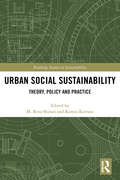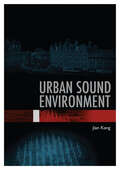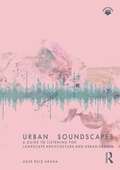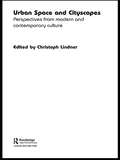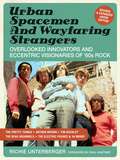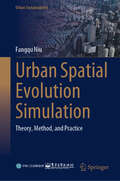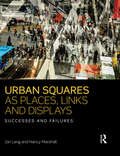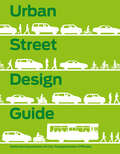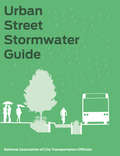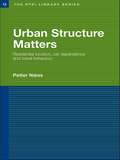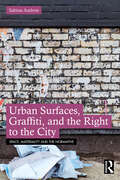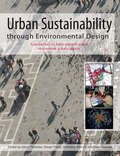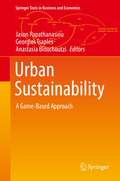- Table View
- List View
Urban Revitalization: Remaking cities in a changing world
by Carl Grodach Renia EhrenfeuchtFollowing decades of neglect and decline, many US cities have undergone a dramatic renaissance. From New York to Nashville and Pittsburgh to Portland governments have implemented innovative redevelopment strategies to adapt to a globally integrated, post-industrial economy and cope with declining industries, tax bases, and populations. However, despite the prominence of new amenities in revitalized neighborhoods, spectacular architectural icons, and pedestrian friendly entertainment districts, the urban comeback has been highly uneven. Even thriving cities are defined by a bifurcated population of creative class professionals and a low-wage, low-skilled workforce. Many are home to diverse and thriving immigrant communities, but also contain economically and socially segregated neighborhoods. They have transformed high-profile central city brownfields, but many disadvantaged neighborhoods continue to grapple with abandoned and environmentally contaminated sites. As urban cores boom, inner-ring suburban areas increasingly face mounting problems, while other shrinking cities continue to wrestle with long-term decline. The Great Recession brought additional challenges to planning and development professionals and community organizations alike as they work to maintain successes and respond to new problems. It is crucial that students of urban revitalization recognize these challenges, their impacts on different populations, and the implications for crafting effective and equitable revitalization policy. Urban Revitalization: Remaking Cities in a Changing World will be a guide in this learning process. This textbook will be the first to comprehensively and critically synthesize the successful approaches and pressing challenges involved in urban revitalization. The book is divided into five sections. In the introductory section, we set the stage by providing a conceptual framework to understand urban revitalization that links a political economy perspective with an appreciation of socio-cultural factors in explaining urban change. Stemming from this, we will explain the significance of revitalization and present a summary of the key debates, issues and conflicts surrounding revitalization efforts. Section II will examine the historical causes for decline in central city and inner-ring suburban areas and shrinking cities and, building from the conceptual framework, discuss theory useful to explain the factors that shape contemporary revitalization initiatives and outcomes. Section III will introduce students to the analytical techniques and key data sources for urban revitalization planning. Section IV will provide an in-depth, criticaldiscussion of contemporary urban revitalization policies, strategies, and projects. This section will offer a rich set of case studies that contextualize key themes and strategic areas across a range of contexts including the urban core, central city neighborhoods, suburban areas, and shrinking cities. Lastly, Section V concludes by reflecting on the current state of urban revitalization planning and the emerging challenges the field must face in the future.Urban Revitalization will integrate academic and policy research with professional knowledge and techniques. Its key strength will be the combination of a critical examination of best practices and innovative approaches with an overview of the methods used to understand local situations and urban revitalization processes. A unique feature will be chapter-specific case studies of contemporary urban revitalization projects and questions geared toward generatingclassroom discussion around key issues. The book will be written in an accessible style and thoughtfully organized to provide graduate and upper-level undergraduate students with a comprehensive resource that will also serve as a reference guide for professionals
Urban Revolution Now: Henri Lefebvre in Social Research and Architecture
by Christian SchmidWhen Henri Lefebvre published The Urban Revolution in 1970, he sketched a research itinerary on the emerging tendency towards planetary urbanization. Today, when this tendency has become reality, Lefebvre’s ideas on everyday life, production of space, rhythmanalysis and the right to the city are indispensable for the understanding of urbanization processes at every scale of social practice. This volume is the first to develop Lefebvre’s concepts in social research and architecture by focusing on urban conjunctures in Barcelona, Belgrade, Berlin, Budapest, Copenhagen, Dhaka, Hong Kong, London, New Orleans, Nowa Huta, Paris, Toronto, São Paulo, Sarajevo, as well as in Mexico and Switzerland. With contributions by historians and theorists of architecture and urbanism, geographers, sociologists, political and cultural scientists, Urban Revolution Now reveals the multiplicity of processes of urbanization and the variety of their patterns and actors around the globe.
Urban Safety and Peacebuilding: New Perspectives on Sustaining Peace in the City (Studies in Conflict, Development and Peacebuilding)
by Oliver Jütersonke Achim WennmannThis volume draws together original research related to conceptual and practical advances at the interface of urban safety and peacebuilding. The book reflects the advances in urban safety and peacebuilding to help address the rapidly increasing risk of conflict and insecurity in cities. Specifically, it draws on contributions to the Technical Working Group on the Confluence of Urban Safety and Peacebuilding Practice, an informal expert network co-facilitated by the United Nations Office at Geneva, UN-Habitat’s Safer Cities Programme, and the Geneva Peacebuilding Platform. A focus on ‘sustaining peace’ serves as a framework for situating new policy responses against conflict, violence, and exclusion in the city, and for promoting a conversation across disciplinary and specialist silos. The volume thereby broadens the optic of peacebuilding practice beyond interstate and intrastate armed conflicts – and especially their aftermath – and reconnects it to the community-level origins of building peace. The analysis and practice presented here will remind those willing to work towards peaceful and inclusive cities that there are tried and tested approaches available, and a host of experts and practitioners ready to accompany those prepared to lead in their respective contexts. This book will be of interest to students and researchers in the fields of peacebuilding, urban studies, security studies, and international relations.
Urban Scandinavian Sewing: 18 Seasonal Projects for Modern Living
by Kirstyn CoganCreate Scandinavian-style wearables and home décor, discover the culture, and enjoy a few recipes, in this unique sewing guide.Stitch your way to Scandinavian style as you embrace minimal, sleek design. Luxuriate in the textures of summery linens and winter wools as you sew 18 projects, from upscale home decor to wearables. You’ll love the chic yet beginner-friendly stitching and embroidery patterns—the perfect way to embellish ready-mades or to sew from scratch. These projects offer beautiful, functional designs for contemporary living. Designer and author Kirstyn Cogan immerses you in her Nordic culture, with handcrafted modern items to make for your home and family—plus scrumptious-sounding recipes and scintillating tidbits about the regional traditions.Praise for Urban Scandinavian Sewing“Another great book for lovers of the modern style. Kirstyn shares her love of Scandinavian culture and design with 18 projects, as well as recipes and stories that transport you to a place of simple beauty and esthetic.” —Quilter’s Connection Magazine“With the book divided into makes for winter and “midsummer,” there should be enough to keep you crafting year-round. The quilting projects are basic, but wouldn't something like this applique quilt just hit the spot thrown over your IKEA Malm bed? And much like our favorite Swedish department store, the addition of meatballs and lingonberry sauce (and other recipes) make for a delightful little quirk that sets this book apart.” —Quilt Now Magazine
Urban Schools: Designing for High Density
by Helen Taylor Sharon WrightWhen space is tight how can a city provide the best education experience for children? Is a multi-storey school really a poor option? Can high-quality play opportunities be provided without playgrounds? This book explores the design of schools in urban settings, the increased challenges in meeting the typical expectations of school design, and what the successful new typology of a school in a city might be. A practical guide as well as a theoretical exploration of ideas, this book outlines successful international contemporary and historical case studies, providing much-needed guidance for architects and others working in education design in dense urban environments.
Urban Segregation and the Welfare State: Inequality and Exclusion in Western Cities
by Sako Musterd Wim OstendorfUrban Segregation and the Welfare State examines ethnic and socio-economic segregation patterns, social polarisation, and social exclusion in major cities in the Western world. Contributors from across North America and Europe provide in-depth analysis of particular cities, ranging from Johannesburg, Chicago and Toronto to Amsterdam, Stockholm and Belfast. The authors highlight the social problems in and of cities, indicating differences between nation-states in terms of economic restructuring, migration, welfare state regimes and "ethnic history".
Urban Sensographies
by Nicolas WhybrowUrban Sensographies views the human body as a highly nuanced sensor to explore how various performance-based methods can be implemented to gather usable ‘felt data’ about the environment of the city as the basis for creating embodied mappings. The contributors to this fascinating volume seek to draw conclusions about the constitution, character and morphology of urban space as public, habitable and sustainable by monitoring the reactions of the human body as a form of urban sensor. This co-authored book is centrally concerned, as a symptom of the degree to which cities are evolving in the 21st century, to examine the effects of this change on the practices and behaviours of urban dwellers. This takes into account such factors as: defensible, retail and consumer space; legacies of modernist design in the built environment; the effects of surveillance technologies, motorised traffic and smart phone use; the integration of ‘wild’ as well as ‘domesticated’ nature in urban planning and living; and the effects of urban pollution on the earth’s climate. Drawing on three years of funded practical research carried out by a multi-medial team of researchers and artists, this book analyses the presence and movement of the human body in urban space, which is essential reading for academics and practitioners in the fields of dance, film, visual art, sound technology, digital media and performance studies.
Urban Services to Ecosystems: Green Infrastructure Benefits from the Landscape to the Urban Scale (Future City #17)
by Maria Beatrice Andreucci Chiara Catalano Riccardo Guarino Francesca Bretzel Manfredi Leone Salvatore PastaThe aim of this book is to bring together multidisciplinary research in the field of green infrastructure design, construction and ecology. The main core of the volume is constituted by contributions dealing with green infrastructure, vegetation science, nature-based solutions and sustainable urban development. The green infrastructure and its ecosystem services, indeed, are gaining space in both political agendas and academic research. However, the attention is focused on the services that nature is giving for free to and for human health and survival. What if we start to see things from another perspective? Our actions shall converge for instance to turn man-made environment like cities from heterotrophic to autotrophic ecosystems. From landscape ecology to urban and building design, like bricks of a wall, from the small scale to the bigger landscape scale via ecological networks and corridors, we should start answering these questions: what are the services that are we offering to Nature? What are we improving? How to implement our actions? This book contains three Open Access chapters, which are licensed under the terms of the Creative Commons Attribution 4.0 International License (CC BY 4.0).
Urban Slums and Circular Economy Synergies in the Global South: Theoretical and Policy Imperatives for Sustainable Communities (Advances in 21st Century Human Settlements)
by Michael Odei Erdiaw-Kwasie Seth Asare Okyere Matthew Abunyewah Festival Godwin BoatengThis book takes a theoretical and empirical distance from urban slums/low-income settlements as a threat to environmental sustainability and recast them as places where environmentally rehabilitative and circular practices occur—drawing on the theoretical lens of the circular economy (CE). CE is defined as regenerative system that minimizes waste, emission, and energy leakage by slowing, closing, and narrowing material and energy loops. In principle, CE departs from the traditional linear model of take-make-use-dispose. As conceived in urban contexts, circular cities offer possibilities to regenerate natural systems, design out waste, and keep products in use. While the CE key principles of reduce, repair, and reuse are essential to the sustainable and inclusive interventions in urban slums, there is lack of case studies exploring the role of place and agency, especially the slum living-CE nexus in global south contexts. In inequitable urban transitions, a nuanced understanding of thesynergies between urban slums and the circular economy is not only theoretically relevant for reconceptualizing the slum in urban sustainability discourses but also exert policy and practice ramifications to decidedly figure out how the urban slum phenomenon can foster the sustainable and inclusive development of marginal areas through contextual and people-centered initiatives.
Urban Smellscapes: Understanding and Designing City Smell Environments
by Victoria HenshawWe see the city, we hear the city, but above all: we smell the city. Scent has unique qualities: ubiquity, persistence, and an unparalleled connection to memory, yet it has gone overlooked in discussions of sensory design. What scents shape the city? How does scent contribute to placemaking? How do we design smell environments in the city? Urban Smellscapes makes a notable contribution towards the growing body of literature on the senses and design by providing some answers to these questions and contributing towards the wider research agenda regarding how people sensually experience urban environments. It is the first of its kind in examining the role of smell specifically in contemporary experiences and perceptions of English towns and cities, highlighting the perception of urban smellscapes as inter-related with place perception, and describing odour’s contribution towards overall sense of place. With case studies from factories, breweries, urban parks, and experimental smell environments in Manchester and Grasse, Urban Smellscapes identifies processes by which urban smell environments are managed and controlled, and gives designers and city managers tools to actively use smell in their work.
Urban Social Housing: Global Health and Climate Change Mitigation and Redress
by Patrick WakelyThis book proposes operational approaches to public sector support to community-led development of urban low-income group social housing in the prevailing and medium-term. Within the context of mitigating and redressing the existential threats of climate change and global pathogenic transmission, building on current concerns of global heating and the lessons learnt from the 2020-22 COVID-19 pandemic, the book closely examines recent examples from a wide international range of countries and cities from the Sri Lanka experience to Arab States of the Middle East and the Andes. Topics include maintenance and management of public sector housing, poverty alleviation objectives, climate change mitigation, housing density, local land management and planning, land rights, affordable housing markets, and international governance and administration, ultimately pointing to the universal need for institutional, organisational and human skills development and the compilation and dissemination of operationally successful examples of participatory partnerships for affordable social housing. The book will be of interest to researchers, instructors, practitioners, and students of urban development, housing, environmental design, land-use planning, public administration and environmental health engineering.
Urban Social Sustainability: Theory, Policy and Practice (Routledge Studies in Sustainability)
by Ramin Keivani M. ShiraziThis ground breaking volume raises radical critiques and proposes innovative solutions for social sustainability in the built environment. Urban Social Sustainability provides an in-depth insight into the discourse and argues that every urban intervention has a social sustainability dimension that needs to be taken into consideration, and incorporated into a comprehensive and cohesive ‘urban agenda’ that is built on three principles of recognition, integration, and monitoring. This should be achieved through a dialogical and reflexive process of decision-making. To achieve sustainable communities, social sustainability should form the basis of a constructive dialogue and be interlinked with other areas of sustainable development. This book underlines the urgency of approaching social sustainability as an urban agenda and goes on to make suggestions about its formulation. Urban Social Sustainability consists of original contributions from academics and experts within the field and explores the significance of social sustainability from different perspectives. Areas covered include urban policy, transportation and mobility, urban space and architectural form, housing, urban heritage, neighbourhood development, and urban governance. Drawing on case studies from a number of countries and world regions the book presents a multifaceted and interdisciplinary understanding from social sustainability in urban settings, and provides practitioners and policy makers with innovative recommendations to achieve more socially sustainable urban environment.
Urban Sound Environment
by Jian KangOver the past two decades there have been many major new developments in the field of urban sound environment. Jian Kang introduces and examines these key developments, including:the development of prediction methods for urban sound propagationestablishment and application of noise-mapping softwarenew noise control measures and design methods.Also
Urban Soundscapes: A Guide to Listening for Landscape Architecture and Urban Design
by Usue Ruiz AranaSound and listening are intrinsically linked to how we experience and engage with places and communities. This guide puts forward a new conceptual framework of embodied affectivity that emphasises listening in urban research and design and advances new ways of knowing and making. The guide invites landscape architects and urban designers to become soundscape architects and offers practical advice on sound and listening applicable to each stage of a design project: from reading the environment to intervening on it.Urban Soundscapes foregrounds listening as an affective mediator between subjects and multispecies environments, and a vehicle to think and conceptualise environmental research and design beyond prevailing visual and human-centred modes. The guide expands landscape architects’ and urban designers’ tools and skills to assess existing soundscapes, predict how those soundscapes will be altered through their designs, consider sound as a creative and active part of the design process and envisage how users might perceive and be affected by those soundscapes as they evolve in time. The volume sits in the interface of research and practice and interweaves theoretical, methodological and creative contributions from acoustic ecology, ecoacoustics, bioacoustics and sound art. Each of the design stages is illustrated through project examples that demonstrate the many advantages of incorporating attentive listening and sound into Landscape Architecture and Urban Design Practice. This book shows how incorporating listening and sounding as part of the design process promotes slow and subtle ways of practice, adds social and ecological value through the reduction of noise pollution and by monitoring the health of habitats, and enables the design of soundscapes that complement the character and design intent of a scheme and elicit joy and wonder.The book will be of interest to practitioners and academics in landscape architecture, and other design and spatial fields such as urban design, architecture, geography and engineering, who play a primary role in the composition of the soundscape.
Urban Space and Cityscapes: Perspectives from Modern and Contemporary Culture (Questioning Cities)
by Christoph LindnerFrom the verticals of New York, Hong Kong and Singapore to the sprawls of London, Paris and Jakarta, this interdisciplinary volume of new writing examines constructions, representations, imaginations and theorizations of 'cityscapes' in modern and contemporary culture. With specially-commissioned essays from the fields of cultural theory, architecture, film, literature, visual art and urban geography, it offers fresh insight into the increasingly complex relationship between urban space, cultural production and everyday life. This volume draws on critical urban studies and moves beyond familiar cultural representations of the city by considering urban planning and architecture. Organized under three inter-related themes - image, text and form - essay topics range from the examination of cyberpunk skylines, pagan urbanism and the cinema of urban disaster, to the analysis of iconic city landmarks such as the twin towers, the London Eye and the Judisches Museum Berlin. Covering a diverse range of cities, including Berlin, Chicago, Jakarta, Johannesburg, Hong Kong, London, Los Angeles, Paris, and Venice, this fantastic resource for students, scholars and researchers alike, works expertly at the intersections of visual, material, and literary culture.
Urban Spacemen and Wayfaring Strangers
by Richie Unterberger"Urban Spacemen & Wayfaring Strangers: Overlooked Innovators & Eccentric Visionaries of '60s Rock" documents twenty cult rockers from the 1960s. The book features extremely detailed investigation of the careers of greats like the Pretty Things, Arthur Brown, Richard & Mimi Fariña, and Tim Buckley. Also featured are the Bonzo Dog Band, the Electric Prunes, Bobby Fuller, the Fugs, Kaleidoscope, Fred Neil, the Beau Brummels, Thee Midniters, Dino Valenti, Mike Brown of the Left Banke, and others, including producers Shel Talmy (the Who, the Kinks, Pentangle) and Giorgio Gomelsky (the Yardbirds, Julie Driscoll, the Soft Machine). In all cases, the extensive chapters include first-hand interview material with the artists themselves and/or their close associates. Lost British Invaders, psychedelic pioneers, rock funnymen, blue-eyed soulsters, overlooked folk-rockers, behind-the-scenes producers -- all find a home as part of "Urban Spacemen & Wayfaring Strangers," with a foreword by Paul Kantner of Jefferson Airplane. The ebook version of "Urban Spacemen & Wayfaring Strangers" is significantly expanded, revised, and updated from the print version, adding 20,000 words of new material. The text is accompanied by illustrations and reviews of the most essential recordings by each artist. From reviews of "Urban Spacemen":"[He] brings to this volume a true fan's love of music combined with a writer's smarts and skills. He seamlessly combines researched material with new interviews. . . Not only did Unterberger choose well musically, but he found the momentum and heart of each of their stories. " -- David Greenberger (essayist on National Public Radio's "All Things Considered"), Pulse!"These fascinating tales will make you want to rush out to the record store -- a hallmark of all great music writing. " -- Jim DeRogatis, Chicago Sun-Times"In each fascinating case study the author tracks down one or more former group members and/or principals in the story, which gives his work both authority and freshness. . . his overall handling of the material is exemplary. "Urban Spacemen" forms a compelling mosaic of the hopes and dreams -- not to mention sharp business practices -- of the decade. " -- Mike Barnes (author of the biography "Captain Beefheart"), The Wire
Urban Spatial Evolution Simulation: Theory, Method, and Practice (Urban Sustainability)
by Fangqu NiuThis book provides a comprehensive introduction to the LUTI model from many aspects such as principles, methods and practice. Since the geometric revolution in the 1960s, model simulation methods have been used in some developed countries to study the development process of urban space and to support urban spatial decision making. One of the most common models is the Land Use Transport Interaction (LUTI) model. At present, relevant research is also gradually emerging in developing countries. This book has the following features: 1. The theory and methods of urban spatial development simulation have been systematically summarised, and practical application research has been carried out. 2. The LUTI model has been systematically explored from theory and implementation method to application practice. 3. The "activity-based" modelling techniques used are at the forefront of LUTI model development.
Urban Squares as Places, Links and Displays: Successes and Failures
by Jon Lang Nancy MarshallTo attract investment and tourists and to enhance the quality of life of their citizens, municipal authorities are paying considerable attention to the quality of the public domain of their cities – including their urban squares. Politicians find them good places for rallies. Children consider squares to be playgrounds, the elderly as places to catch-up with each other, and for many others squares are simply a place to pause for a moment. Urban Squares as Places, Links and Displays: Successes and Failures discusses how people experience squares and the nature of the people who use them. It presents a ‘typology of squares’ based on the dimensions of ownership, the square’s instrumental functions, and a series of their basic physical attributes including size, degree of enclosure, configuration and organization of the space within them and finally based on their aesthetic attributes – their meanings. Twenty case studies illustrate what works and what does not work in different cities around the world. It discusses the qualities of lively squares and quieter, more restorative places as well as what contributes to making urban squares less desirable as destinations for the general public. The book closes with the policy implications, stressing the importance and difficulties of designing good public places. Urban Squares offers how-to guidance along with a strong theoretical framework making it ideal for architects, city planners and landscape architects working on the design and upgrade of squares.
Urban Street Design Guide
by National Association of City Transportation OfficialsThe NACTO Urban Street Design Guide shows how streets of every size can be reimagined and reoriented to prioritize safe driving and transit, biking, walking, and public activity. Unlike older, more conservative engineering manuals, this design guide emphasizes the core principle that urban streets are public places and have a larger role to play in communities than solely being conduits for traffic. The well-illustrated guide offers blueprints of street design from multiple perspectives, from the bird's eye view to granular details. Case studies from around the country clearly show how to implement best practices, as well as provide guidance for customizing design applications to a city's unique needs. Urban Street Design Guide outlines five goals and tenets of world-class street design: * Streets are public spaces. Streets play a much larger role in the public life of cities and communities than just thoroughfares for traffic. * Great streets are great for business. Well-designed streets generate higher revenues for businesses and higher values for homeowners. * Design for safety. Traffic engineers can and should design streets where people walking, parking, shopping, bicycling, working, and driving can cross paths safely. * Streets can be changed. Transportation engineers can work flexibly within the building envelope of a street. Many city streets were created in a different era and need to be reconfigured to meet new needs. * Act now! Implement projects quickly using temporary materials to help inform public decision making. Elaborating on these fundamental principles, the guide offers substantive direction for cities seeking to improve street design to create more inclusive, multi-modal urban environments. It is an exceptional resource for redesigning streets to serve the needs of 21st century cities, whose residents and visitors demand a variety of transportation options, safer streets, and vibrant community life.
Urban Street Stormwater Guide
by National Association of City Transportation OfficialsThe Urban Street Stormwater Guide begins from the principle that street design can support—or degrade—the urban area's overall environmental health. By incorporating Green Stormwater Infrastructure (GSI) into the right-of-way, cities can manage stormwater and reap the public health, environmental, and aesthetic benefits of street trees, planters, and greenery in the public realm.Building on the successful NACTO urban street guides, the Urban Street Stormwater Guide provides the best practices for the design of GSI along transportation corridors.The state-of-the-art solutions in this guide will assist urban planners and designers, transportation engineers, city officials, ecologists, public works officials, and others interested in the role of the built urban landscape in protecting the climate, water quality, and natural environment.
Urban Structure Matters: Residential Location, Car Dependence and Travel Behaviour (RTPI Library Series)
by Petter NaessGoing beyond previous investigations into urban land use and travel, Petter Næss presents new research from Denmark on residential location and travel to show how and why urban spatial structures affect people's travel behaviour. In a comprehensive case study of the Copenhagen metropolitan area, Næss combines traditional quantitative travel surveys with qualitative interviews in order to identify the more detailed mechanisms through which urban structure affects travel behaviour. The case study findings are compared with those from other Nordic countries and analyzed and evaluated in the light of relevant theory and literature to provide solid, valuable conclusions for planning sustainable urban development. With a broader range of statistics than previous studies and conclusions of international relevance, Urban Structure Matters provides well-grounded conclusions for how spatial planning of urban areas can be used to reduce car dependence and achieve a more sustainable development of cities.
Urban Surfaces, Graffiti, and the Right to the City
by Sabina AndronThis landmark book focuses on urban surfaces, on exploring their authorship and management, and on their role in struggles for the right to the city. Graffiti, pristine walls, advertising posters, and municipal signage all compete on city surfaces to establish and imprint their values on our environments. It is the first time that the surfacescapes of our cities are granted the entire attention of a book as material, visual, and legal territories. The book includes a critical history of graffiti and street art as contested surface discourses and argues for surfaces as sites of resistance against private property, neoliberal creativity, and the imposition of urban order. It also proposes a seven-point manual for a semiotics of urban surfaces, laying the ground for a new discipline: surface studies. Page after page and layer after layer, surfaces become porous and political and emerge as key spatial conditions for rethinking and re-practicing urban dwelling and spatial justice. They become what the author terms the surface commons. The book will appeal to a wide readership across the disciplines of urban studies, architectural theory and design, graffiti, street art and public art, criminology, semiotics, visual culture, and urban and legal geography. It will also serve as a tool for city scholars, policy makers, artists, and vandals to disrupt existing imaginaries of order, justice, and visibility in cities.
Urban Surfaces, Graffiti, and the Right to the City (ISSN)
by Sabina AndronThis book explores the ownersheir authorship and management, and their role in struggles for the right to the city. Includes a critical history of graffiti and street art as contested surface discourses. Interdisciplinary appeal.
Urban Sustainability Through Environmental Design: Approaches to Time-People-Place Responsive Urban Spaces
by Kevin Thwaites Sergio Porta Ombretta Romice Mark GreavesWhat can architects, landscape architects and urban designers do to make urban open spaces, streets and squares, more responsive, lively and safe? Urban Sustainability through Environmental Design answers this question by providing the analytical tools and practical methodologies that can be employed for sustainable solutions to the design and management of urban environments. The book calls into question the capability of ‘quick-fix’ development solutions to provide the establishment of fixed communities and suggests a more time-conscious and evolutionary approach. This is the first significant book to draw together a pan-European view on sustainable urban design with a specific focus on social sustainability. It presents an innovative approach that focuses on the tools of urban analysis rather than the interventions themselves. With its practical approach and wide-ranging discussion, this book will appeal to all those involved in producing communities and spaces for sustainable living, from students to academics through to decision makers and professional leaders.
Urban Sustainability: A Game-Based Approach (Springer Texts in Business and Economics)
by Jason Papathanasiou Georgios Tsaples Anastasia BlouchoutziThis textbook provides an innovative pedagogy to students who will be the policy makers of tomorrow. It provides thoughts on sustainability and the complexity among its different dimensions. It guides students through experience, processes of complex decision making, and sharpen their clarity of thought, to enhance their communication abilities and help them develop critical thinking. It provides key competencies to address the complexities of sustainable development.By combining game-based learning with an analytical style of education, supplemental materials are provided to make the definitions of various sustainability aspects more concrete and allows students to experiment in a consequence-free environment, with scenario examples. Board Game and a hypothetical management course, dealing with various topics like transportation sustainability, societal metabolism, etc. as well as with decision making under those contexts, will formalize the mathematics needed to make robust decisions.
